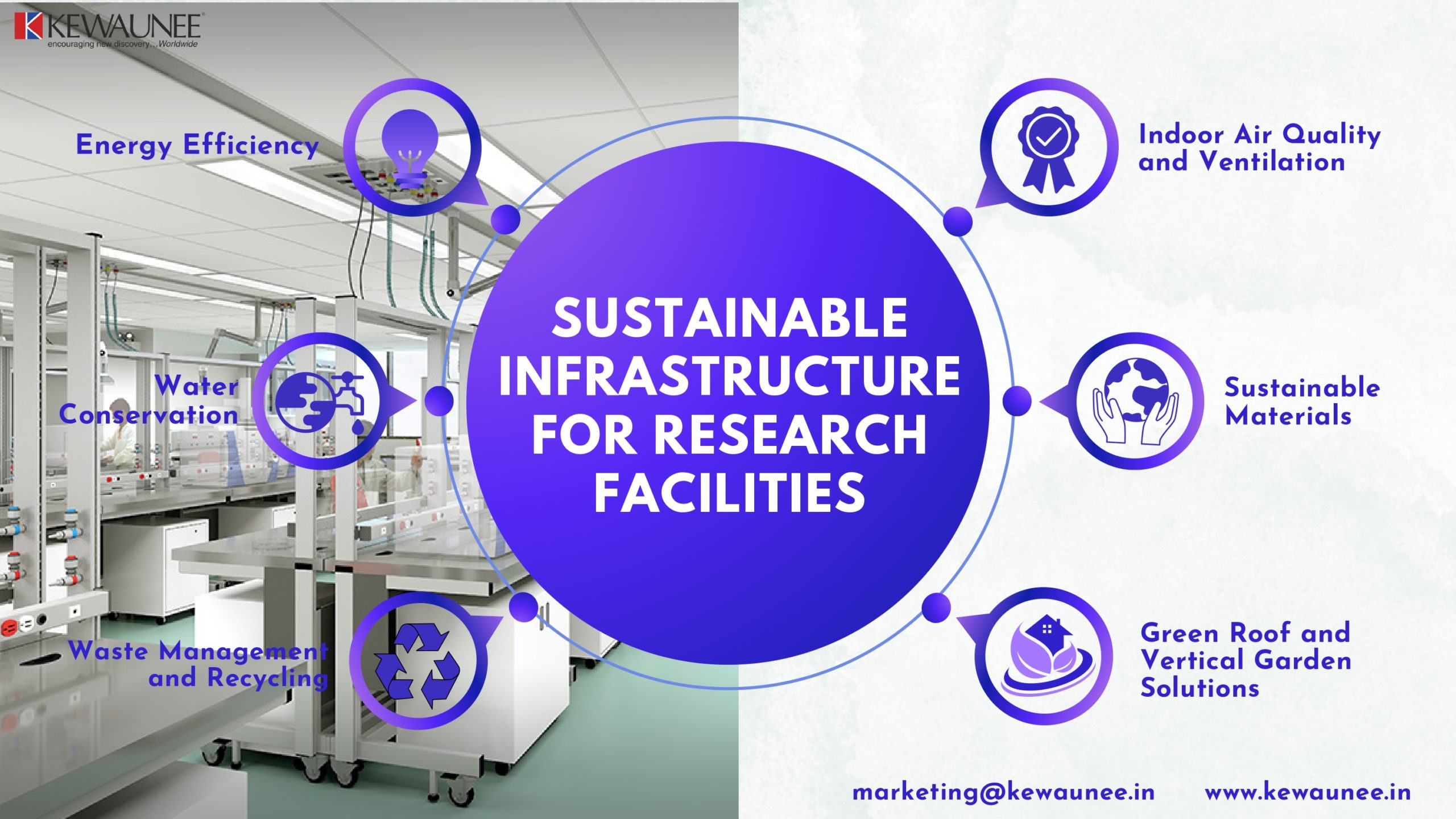Sustainable Infrastructure for Research Facilities
In today’s world, sustainability is a critical consideration in all aspects of our lives, including laboratory and research facility design. As centers of scientific discovery and innovation, research facilities have a unique opportunity to contribute to a greener future by implementing sustainable design practices.
This blog will explore the importance of sustainable design in research facilities and provide an overview of green infrastructure solutions that can be incorporated into laboratory design.
I. Understanding Sustainable Design in Laboratories
Sustainable design principles are based on minimizing environmental impact and optimizing resource efficiency throughout a facility’s life cycle. In research facilities, these principles include energy efficiency, water conservation, waste management, and indoor air quality.
By adopting sustainable design practices, research facilities can reduce their carbon footprint and create healthier, more productive work environments.
II. Energy Efficiency in Laboratory Design
A. Designing for energy-efficient lighting:
Proper lighting design plays a crucial role in energy efficiency. LED lighting technology offers significant energy savings compared to traditional lighting options, with long lifespans and reduced maintenance requirements.
Additionally, optimizing the use of natural lighting through proper window placement and daylight harvesting can further reduce energy consumption.
B. Energy-efficient HVAC systems:
Heating, ventilation, and air conditioning (HVAC) systems account for a significant portion of energy usage in research facilities. Implementing variable air volume (VAV) systems allows for better control of airflow and temperature, reducing energy waste.
Energy recovery ventilation systems help recover and reuse energy from exhaust air, further improving energy efficiency.
C. Integration of renewable energy sources:
Research facilities can harness renewable energy sources like solar power and geothermal heating and cooling. Installing solar panels on rooftops and utilizing geothermal heat pumps can offset energy consumption and reduce reliance on traditional power sources.
III. Water Conservation Strategies
A. Efficient water management systems:
Research facilities can implement low-flow fixtures and faucets to minimize water consumption without compromising functionality. These water-saving technologies help conserve water resources while maintaining proper hygiene standards.
B. Rainwater harvesting:
Collecting and storing rainwater for non-potable uses, such as irrigation and toilet flushing, can significantly reduce the demand for freshwater. Research facilities can invest in rainwater collection systems and utilize the harvested water in landscaping and other non-critical applications.
IV. Waste Management and Recycling
A. Proper disposal of hazardous materials:
Research facilities must prioritize safe disposal of hazardous waste, including chemicals and electronic waste (e-waste). Implementing proper waste management protocols, including segregation, labeling, and partnering with certified disposal vendors, ensures compliance with regulations and minimizes environmental impact.
B. Recycling programs in research facilities:
Promoting recycling within research facilities helps reduce waste generation and conserve resources. Implementing recycling programs for materials such as paper, plastic, and laboratory glassware encourages responsible waste disposal and contributes to a circular economy.
V. Sustainable Materials and Furniture
A. Eco-friendly lab furniture options:
Choosing sustainable materials for lab furniture, such as FSC-certified wood and recycled plastics, reduces environmental impact and promotes responsible sourcing. Non-toxic and low-VOC finishes contribute to better indoor air quality, creating a healthier and more sustainable laboratory environment.
B. Green procurement practices:
Research facilities can adopt green procurement practices by selecting environmentally friendly materials and equipment. Conducting life-cycle assessments and considering factors like durability, energy efficiency, and recyclability can guide procurement decisions towards more sustainable options.
VI. Indoor Air Quality and Ventilation
A. Enhanced ventilation systems:
Proper ventilation is crucial for maintaining good indoor air quality in research facilities. High-efficiency air filters help remove particulates and contaminants from the air, creating a healthier and more productive environment for researchers and staff.
B. Volatile organic compound (VOC) management:
Reducing VOC emissions is essential for maintaining a healthy indoor environment. Research facilities can choose low-emission materials and furnishings, such as paints, adhesives, and furniture, to minimize the release of harmful chemicals. Regular air quality monitoring and control systems help maintain optimal air quality levels.
VII. Green Roof and Vertical Garden Solutions
A. Benefits of green roofs in research facilities:
Green roofs offer numerous benefits, including stormwater management by absorbing and filtering rainwater. They also provide insulation, reducing the energy needs for heating and cooling. Additionally, green roofs create a more aesthetically pleasing environment and support biodiversity.
B. Vertical gardens for improved air quality:
Vertical gardens, also known as living walls, can enhance indoor air quality by absorbing carbon dioxide and releasing oxygen. Proper plant selection and installation ensure effective air purification, while also adding a touch of natural beauty to research facilities. Biophilic design principles can further enhance the positive impact of vertical gardens on occupants’ well-being.
XIII. Future Trends and Innovations
A. Advancements in sustainable lab design:
Emerging trends and innovations in sustainable laboratory design, such as net-zero energy laboratories that generate as much energy as they consume. Smart grid integration and the use of Internet of Things (IoT) technology for energy and resource optimization are also promising areas for future sustainability improvements.
B. Integration of IoT technology for energy and resource optimization:
Exploring the potential of real-time monitoring and control systems powered by IoT technology to optimize energy consumption, enhance resource management, and enable data-driven decision-making for sustainability.
IX. Conclusion
In conclusion, designing sustainable laboratories is crucial for research facilities to minimize their environmental impact and create healthier work environments. By incorporating green infrastructure solutions, such as energy-efficient lighting, water conservation strategies, waste management programs, sustainable materials and furniture, indoor air quality enhancements, and green roof and vertical garden solutions, research facilities can achieve significant sustainability improvements.
These initiatives not only contribute to a greener future but also have positive impacts on cost savings, occupant well-being, and the overall reputation of the institution. By embracing sustainable design principles and adopting green infrastructure solutions, research facilities can lead the way in creating a more environmentally friendly and resource-efficient laboratory environment. It is crucial for organizations to prioritize sustainability and make a positive impact on the planet while advancing scientific innovation.
Comments are closed.











